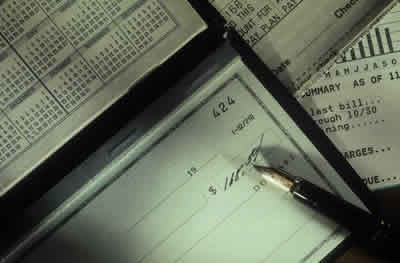 If your company has a policy that allows you to give your employees advances on upcoming payroll, you can use QuickBooks® and QuickBooks® Payroll to record the advance, which can then be reimbursed to the company through payroll deductions. We recommend that you document any loans to employees with terms for repayment clearly spelled out and signed by both parties.
If your company has a policy that allows you to give your employees advances on upcoming payroll, you can use QuickBooks® and QuickBooks® Payroll to record the advance, which can then be reimbursed to the company through payroll deductions. We recommend that you document any loans to employees with terms for repayment clearly spelled out and signed by both parties.
Note: This QuickBooks® tip assumes that you have an active QuickBooks® payroll subscription.
First, create an Asset Account to Track the Employee Loan and Repayment
This is a one-time setup task
- Go to the Lists menu and click Chart of Accounts
- Click Account at the bottom of the list and then click New
- Under Other Account Types choose Other Current Asset and then click Continue
- If you are using account numbers, enter the number in the Numbers field
- In the Account Name field, enter Employee Advances
- Click Save & Close
Next, you can either write a regular check (non-payroll) to the Employee for the Advance and post it to the Other Current Asset account Employee Advances or you can pay the Advance through Payroll in which case you will need to create a Payroll Item of the type “addition”.
This is a one-time setup task.
- Go to the Lists menu and click Payroll Item List
- Click Payroll Item at the bottom of the list and then click New
- Select the Custom Setup method and click Next
- Choose Addition and click Next
- Enter the name for this addition as Employee Loan
- Click Next
- On the Expense Account screen, choose the Other Current Asset account, Employee Advances, that you created in Step 1 for tracking this expense and click Next
- Select None as the tax tracking type
- Leave the taxes unchecked and click Next
- Select Neither in the calculate based on quantity screen and click Next
- Select Net Pay and click Next
- Leave the default rate and limit blank and click Finish
Use this addition on the Employee’s paycheck under Other Payroll Items. Enter this amount as a positive number.
Then, create another Payroll Item of the type “deduction”Again, this is a one-time setup task.
- Go to the Lists menu and click Payroll Item List
- Click Payroll Item at the bottom of the list and then click New
- Select the Custom Setup method and click Next
- Choose Deduction and click Next
- Enter the name for this deduction as Loan Repayment and click Next
- Leave the first two fields blank, then under the Liability account field, choose the Other Current Asset account, Employee Advances, that you created in Step 1 for tracking this expense and click Next
- Select None as the tax tracking type and click Next
- Leave the taxes unchecked and click Next
- Select Neither in the calculate based on quantity screen and click Next
- Select Net Pay and click Next
- Enter a default rate and limit if desired and then click Finish
Note: You should only enter a default rate and limit if the rate and limit will apply to everyone using the Payroll Item. The limit may be marked as an annual limit and if so, you will need to manually adjust or remove the amount at the beginning of the calendar year or it will start recalculating.
Use this deduction on the Employee’s paycheck under Other Payroll Items. Enter this amount as a negative number.
Create a Custom Summary Payroll Report to Track Employee Loan Balances
- Go to Reports
- Select Employees & Payroll
- Select Payroll Summary
- Click on Customize Report in the upper left corner
- On the Display tab, choose All Dates
- Select Payee in the Display Columns by drop-down menu
- Check % of Row and uncheck Hours and Rate
- Click on the Filters tab, select Accounts and choose the Other Current Asset account used for the Employee Advances on the drop-down menu
- Click OK
Manage Employee Loans that will be Repaid over Time on Multiple Paychecks
- Edit the Employee
- Change tabs to Payroll and Compensation Info
- Under Additions, Deductions and Company Contributions select the Loan Repayment Payroll Item
- Enter the amount to be paid by paycheck in the Amount column as a negative amount.
- Enter the balance remaining to be paid at this point into the Limit column as a negative amount.
- Click OK
Note: QuickBooks® will automatically deduct this repayment on each paycheck and will stop the deduction once the limit has been reached.
This article of QuickBooks Tips and Tricks was based on the 2012 version of QuickBooks.
 When you run financial statements on a Cash Basis in QuickBooks®, the results may not be what you expect. For example, you may find balances for Accounts Receivable and/or Accounts Payable on Balance Sheets run on a Cash Basis. This often means that the client has assigned a Payable or a Receivable to a Balance Sheet account, rather than to an Expense or Income account. There are other reasons this happens too.
When you run financial statements on a Cash Basis in QuickBooks®, the results may not be what you expect. For example, you may find balances for Accounts Receivable and/or Accounts Payable on Balance Sheets run on a Cash Basis. This often means that the client has assigned a Payable or a Receivable to a Balance Sheet account, rather than to an Expense or Income account. There are other reasons this happens too.
Reasons for Accounts Receivable on a Cash Basis Balance Sheet
- There may be open balances on Invoices that use Items linked to Balance Sheet accounts. An example would be a Customer Deposit linked to a Liability account.
- There may be a prorata cost of Inventory Items listed on open Invoices. For example, if an Invoice that includes Inventory Part Items is half paid, half the cost of the Inventory Part Items will remain in Accounts Receivable.
- There may be unapplied credits from Credit Memos or Payments. You can find these entries easily because they appear as negative numbers on the Open Invoices report.
- There may be Sales Tax due listed on an accrual basis. You can change the Sales Tax Preference to Cash Basis to eliminate this problem. CAUTION: Check with your State taxing agencies for rules regarding payment of Sales Tax – some States require the basis for Sales Tax accruals to match the basis for Income Tax filing.
Reasons for Accounts Payable on a Cash Basis Balance Sheet
- There may be Bills using Items linked to Balance Sheet accounts.
- There may be Bills entered for a Note Payable or to buy a Fixed Asset.
- You may find the cost of Inventory Part Items on open Bills.
- There may be unapplied Vendor Credits or Prepayments.
To review balances in Accounts Receivable and/or Accounts Payable:
Filter a transaction report with a paid status of Open transactions and date range of All to get a report showing the transactions that QuickBooks® did not reverse as part of the internal Cash Basis conversion.
- From the Reports menu, choose Company & Financial
- Choose Balance Sheet Standard from the submenu
- Click Customize Report
- Select Cash as the Report Basis
- Click OK
- Double-click the balance in the Accounts Receivable and/or Accounts Payable account
- Click Customize Report, and then click the Filters tab
- In the Filters list, select Paid Status and then select Open
- Click OK
Complete the Cash Basis Conversion
To complete the Cash Basis conversion, use a Journal Entry to adjust away the Accounts Receivable and/or Accounts Payable balances. For the Journal Entry, create a Customer called ***A/R CPA Use Only*** and an Accounts Payable Vendor called ***A/P CPA Use Only***. Use these names to transfer the balances to whatever accounts you choose for the adjustments.
These Journal Entries are Reversing Entries as of the first day in the next fiscal period and you must apply the Journal Entry and the Reversing Entry against each other to offset them or you will have Unapplied Credits going forward.
Do not use Accounts Receivable and/or Accounts Payable as the first line of a journal entry in QuickBooks®. To find out why, see our next Accounting Professionals Only newsletter.
Please contact me if you have any questions or need further details regarding this information. This article was based on the 2012 version of QuickBooks®.
Rhonda Rosand, CPA
Certified QuickBooks® ProAdvisor
New Business Directions
 Please note that you should rarely need to void a payroll check. Remember that voiding a payroll check is not like voiding other kinds of checks; paychecks have associated tax and other liability calculations and payments that need to be taken into consideration. You are required to amend and file corrected payroll tax returns if you void a paycheck from a previous tax period.
Please note that you should rarely need to void a payroll check. Remember that voiding a payroll check is not like voiding other kinds of checks; paychecks have associated tax and other liability calculations and payments that need to be taken into consideration. You are required to amend and file corrected payroll tax returns if you void a paycheck from a previous tax period.
To correctly replace a lost or destroyed paycheck and ensure that your payroll data remains accurate, you need to print a replacement check with a new check number and make a record of the lost or destroyed check.
Find the Paycheck in QuickBooks®
First, open the check register and find the paycheck that was lost or destroyed. In the Banking section on the Home page, click the Check Register icon. If you have more than one bank account, select the appropriate account and click the OK button. This brings up the Check Register where you can search for the lost or destroyed paycheck. You could also search for this check in the Employee Center.
Once you find the original paycheck, make a note of the check number and the net pay amount. You will need these later.
Double-click the entry in the register to open the Paycheck window. Select the To be printed checkbox and click the Print button at the top of the window to reprint the check using the next check number in your numbering sequence. Click Save & Close in the Paycheck window and close the check register.
This is the replacement paycheck that you will give the employee.
The next steps create a record of the lost or destroyed paycheck.
In the Banking section on the Home page, click the Write Checks icon.
-
- Use the same check number as the original lost or destroyed check.
- Make the date the same as the day the check was originally written.
- Make the check payable to the employee (ignore the message about using the built-in payroll features.)
- Make the check amount the net payment amount from the original check.
- Note in the memo line that this check was replaced by the check you reprinted.
- On the Expenses tab, choose Payroll Expenses in the Account column.
Click Save & Close.
Open the check register again. Find the check you just created, right-click it, and click Void Check.
You should now see the word “VOID” in the Memo field and a check amount of “0.00.” You now have a record in your check register of the lost or destroyed check.

*Please note that clients using the Assisted Payroll service and/or QuickBooks® Payroll with Direct Deposit may need to perform additional steps when reissuing paychecks to Employees.
This article of QuickBooks Tips and Tricks was based on the 2012 version of QuickBooks.
New in 2012 – QuickBooks® Accountant and Enterprise Accountant versions only
Starting with the 2012 version of QuickBooks® Accountant and QuickBooks® Enterprise Accountant, accounting professionals can now set a date range to extract transactions for a specified period of time and condense transactions outside the date range.
This preserves transactions in the condensed file only for a particular period with entries prior to that period summarized and entries after that period removed.
This is useful for clients with file size and list limit issues as well as for third-party requests of information – not only for audit requests, but also in the event of a business sale, a divorce or legal dispute when you do not need to provide the entire QuickBooks® file.
First thing – BACKUP your data file.
You are creating a new file to be issued to a third-party and you do not want to overwrite your working file.
Then under the FILE menu, UTILITIES, CONDENSE DATA – Accept the prompt that it is ok to lose Budget data.
When it prompts you for what transactions you want to remove, select “Transactions outside of a date range” to prepare a period copy of the company file. Set your before and after dates to include the period you want to keep.

Then when it prompts you how transactions should be summarized, choose “Create one summary journal entry”.

Remove the recommended transactions.

Remove the unused list entries.

Begin Condense.
This article of QuickBooks Tips and Tricks was based on the 2012 version of QuickBooks.
 New Business Direction LLC
New Business Direction LLC
